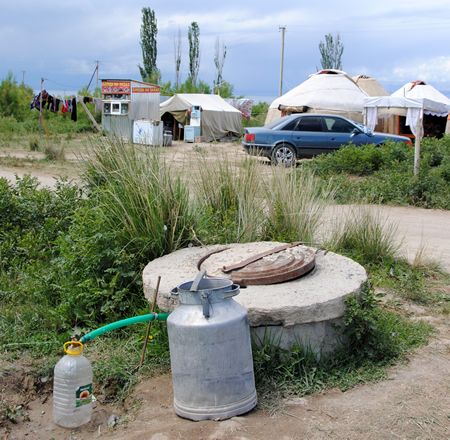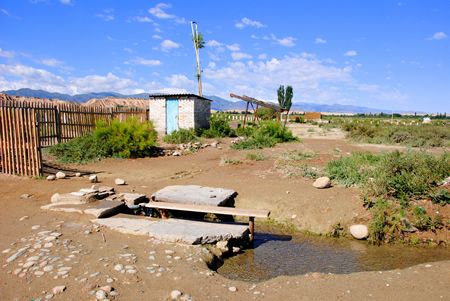July 16, 2013
I started thinking about
this back when I was in Toguz Bulak, and the thoughts have continued on into
Bar Bulak. The round table discussion that we had the other day brought up this
topic, and as such, I’ve been thinking about it even more. Both Toguz Bulak
(“Nine Springs”) and Bar Bulak (“There are springs”) have no real shortage of
water in a literal sense. It kind of pops up out of the ground all over the
place. However, despite the fact that there is water about, both places definitely
have a water supply problem, and running water exists in neither village.
I’m not too clear on the
timeline, but according to the folks in Bar Bulak, roughly 10-15 years ago or
so, the UN started a program to provide clean drinking water to the rural areas
of the Issyk Kul region (in which both Toguz Bulak and Bar Bulak are located).
The project started… and then something happened to the funds. Whether the
money was simply mismanaged or blatantly stolen, no one seems to know for sure
(although most folks assume the latter). The UN money ran out before the wells
were completed, and the UN cancelled the program. Aris, a Kyrgyzstan-based NGO
that focuses on development projects stepped up to finish the job. Sort of.
They finished installing wells in many villages (including Toguz Bulak), but
never made it to many other villages (including Bar Bulak).

scattered throughout rural Kyrgyzstan.
Let’s examine the results of
the UN/Aris project in Toguz Bulak first. Toguz Bulak is hardly a huge village
by anyone’s measurement, although it’s several times larger than Bar Bulak
population-wise. It’s laid out along a grid, with the houses fairly close
together. The UN/Aris program installed one well per block, which in my
estimation comes to roughly 24 wells. Fast-forward to the present day. I’d say
maybe four of those wells still work as intended. Maybe. Probably about ten
work, but poorly. The one on “my” block could only be turned on/off with a
wrench. Several other wells throughout the village also had similar methods of
being turned on/off. In contrast, several other wells ran constantly, having no
shut-off function whatsoever. The rest of the wells in the village simply
didn’t work at all.


The wells were designed to
operate without electricity. This is great, since regular, reliable electricity
has only recently come to Toguz Bulak. Instead of using an electric pump to
bring the water to the surface, the pumps operate on water-pressure. You turn
on the spigot, and the pressure forces the water up and out of the well. Great,
huh? Well, unfortunately, the underground water supply isn’t that great.
Whether it comes from the same source as the nine springs from which Toguz
Bulak gets its name, I don’t know. What I do know is that sometimes it runs
dry. The fact that there are several wells which run non-stop surely is a
contributing factor. Whatever the reason, sometimes the wells are turned on and
either nothing – or a tiny little trickle – comes out.
We were lucky to have a
working well on our block. Many families must cart their buckets several blocks
to get water – and keep in mind that this water is used for everything:
cooking, cleaning, clothes-washing, bathing, watering livestock, irrigation,
etc. That’s a lot of water to haul for several blocks! My host family (and many
others) also collected run-off from the gutters of their homes and
out-buildings to use for irrigation and watering livestock. Several of the
springs were located in a swampy area to the north-west of the village; most
people herded their cows and sheep into this area during the day, so that they
could graze on the freshly watered grass and drink from the water seeping out
of the ground. People made do with the broken wells, although it certainly
wasn’t easy.


So how did this happen? How
did Toguz Bulak go from having one working well per block to the situation in
which they find themselves today? Well, this is indeed one of those sustainable development issues. First
you must consider that for decades under the Soviet Union all infrastructure
changes (for good or ill) were made in either Frunze (now Bishkek) or in
Moscow. Locals grew accustomed to making no decisions regarding their local
infrastructure; someone from above would always come along and tell them how to
do it. Following the collapse of the Soviet Union – after decades of being
told how from above to manage their villages – rural villages have been rather
slow at coming to the realization that they need to take care of things
themselves.
A few years after the
collapse of the Soviet Union – and while still laboring under the mindset that
people from above would solve their infrastructure problems – the locals of
Toguz Bulak were suddenly treated to the sort of thing they had come to expect:
the UN/Aris well project. The UN and Aris came in from above and donated wells,
meaning that the locals no longer had to get their water from the swampy
“springs” and melting mountain snows. Unfortunately, all the UN/Aris project
did was install the wells. None of the locals were trained in how to properly
maintain or repair the wells. No money was provided to the village to cover the
cost of maintenance or repairs, and Aris themselves did not provide any
maintenance or repair services. Over the years the wells have simply begun to
break – and it seems that the locals are still waiting for someone to come from
above and solve their water woes.
Now let’s examine the water
situation in Bar Bulak. In many ways it is similar to the situation in Toguz
Bulak, although there are some key differences. Unlike in Toguz Bulak, the
wells in Bar Bulak from the UN/Aris well project were only half installed. If
you compare the photos of the wells in Toguz Bulak and their counterparts in
Bar Bulak, you can see that they are identical, except for the fact that the
ones in Bar Bulak were never fully assembled. Sadly, it seems that at one time,
all of the pieces were available, they just needed to be connected; however,
this never happened. The wells have never worked, and now most of the parts
have either broken or disappeared.




While Toguz Bulak had its
nine “springs” it lacked any central water source. Bar Bulak, in contrast, has
a small river running through it, which is both spring-fed and fed from
snow-melts. As in many villages (and even Bishkek) the water from this river is
routed through the village by a network of ditches, creeks, pipes, and concrete
troughs. These miniature waterways (called арык, or aryk) enable the river/spring water to
reach every home in the village, where it can be used for any purpose. Yes,
many people rely on aryk-water for cooking, in addition to cleaning,
irrigation, watering livestock, etc.


One of the many spring-sources for the river




However, not everyone here
in Bar Bulak relies on the river/aryk system to provide their water. My host family
(as well as several other families in the village) had a hand-pump well
installed on their property several years ago. They use the hand-pump well for
all water-related purposes except irrigation (for which they use water from the
aryk). The water from the hand pump is clean and tasty – they drink from it, so
I do as well. (Although given the stomach troubles I’ve had while here, I do
wonder about the cleanliness of the water coming from our well.) The nearby
neighbors frequently come over to my host family’s property to fill their
buckets from the hand-pump, and I would assume the same thing occurs at the
other hand-pump-owning properties in the village. It’s quite far from a perfect
solution, but it does seem to be rather a step in the right direction.

filling up buckets for her family from my host family's well.
The area where the yurt camp
is located down by the lake shore also has several UN/Aris wells, although most
do not work at all. Two have been rigged by the locals to produce a slow
trickle of water. Locals also believe in the health benefits of drinking the
water from the hot springs, so many collect water from the outdoor section of
said springs.

Lake Issyk Kul has a high salt content, which makes it unpalatable and useless for irrigation.



The outdoor area of the hot springs, where many people collected water.
I should also mention that
the London School’s Beach Camp “hotel” located next to the yurt camp (and where
I will be staying next week) has running water, as they have paid to have an
electric well installed, although the water pressure varies from excellent to
near nonexistent. Such things are available, one just has to be willing to
shell out the funds to cover the costs.
I’m not sure what the
solution should be for the water woes of villages such as Toguz Bulak and Bar
Bulak. Neither village has running water or a reliable supply of clean drinking
water available to all residents. Simply donating wells certainly didn’t work.
Only a few families in Bar Bulak can afford to have a hand-pump well installed,
and the technology for such a thing is inaccessible in Toguz Bulak. In communities
where money is scarce, people simply can’t afford to buy well-drilling
equipment or pay for its use. The donation of such items/services doesn’t lead
to a sustainable solution. So what is the solution? I have no idea, but I’ve
been thinking about this a lot over the past two months. What are your
thoughts?
(Also, special thanks to my
students Ryskul and Alia who helped me locate and photograph the various water
sources around Bar Bulak, as well as to Aliman and Murat who showed me the springs
of Toguz Bulak.)



No comments:
Post a Comment